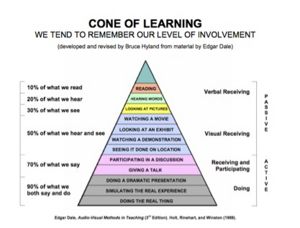Gaining Foundation Skills for Learning and Teaching/GFS Learning Module
Contents
[hide]GFS Learning Module
This module introduces you (as an adult teacher/facilitator) to aspects of learning and learning styles.The activities and reflections in this module are to assist with your learning and you may wish to record these in some format such as a learning journal.
What is Learning?
.
Compare your thoughts with this dictionary definition:
Learning
"1. knowledge gained by study; instruction or scholarship
2. the act of gaining knowledge
3. (Psychology) Psychol any relatively permanent change in behaviour that occurs as a direct result of experience
Collins English Dictionary – Complete and Unabridged 6th Edition 2003. © William Collins Sons & Co. Ltd 1979, 1986 © HarperCollins
Publishers 1991, 1994, 1998, 2000, 2003
Retrieved on 28 January 2010 from: http://www.thefreedictionary.com/learning
teach
"(t ch) v. taught (tôt), teach·ing, teach·es v.tr.
1. To impart knowledge or skill to: teaches children.
2. To provide knowledge of; instruct in: teaches French.
3. To condition to a certain action or frame of mind: teaching youngsters to be self-reliant.
4. To cause to learn by example or experience: an accident that taught me a valuable lesson.
5. To advocate or preach: teaches racial and religious tolerance.
6. To carry on instruction on a regular basis in: taught high school for many years. v.intr. To give instruction, especially as an occupation.
The American Heritage® Dictionary of the English Language, Fourth Edition copyright ©2000 by Houghton Mifflin Company. Updated in
2009. Published by Houghton Mifflin Company. All rights reserved.
Retrieved on 28 January 2010 from:http://www.thefreedictionary.com/teach
"Today's adult educators recognize that it is no longer sufficient for teachers to teach and trainers to train. Rather than focus on information acquisition or behavior modification, they have expanded their efforts to emphasize the process of learning and its impact on adult development."
- Taylor, K., Marienau, C., & Fiddler, M.(2000). Developing Adult Learners: Strategies for Teachers and Trainers. California, Jossey-Bass Inc. (Cover flap)
- Taylor, K., Marienau, C., & Fiddler, M.(2000). Developing Adult Learners: Strategies for Teachers and Trainers. California, Jossey-Bass Inc. (Cover flap)
There has been a large shift in education from a focus on what is being taught by the teacher to a focus on the learner and what, why and how they are learning.
Even though the above quote is now 10 years old there are still many educators who focus solely on content.
Learning Approaches
In exploring adult learning there are several key factors to consider when thinking about how people learn and the ways in which they make meaning of information and experience. The first is the approach to learning. This can occur on different levels. The most significant being a deep learning approach compared to a surface learning approach.
Read this Summary of Learning Approaches(<- click on this link) and ponder the following questions:
|
Retaining what we learn
What is the best way to help us retain what we learn?
| Estimate the percentage (out of 100% for each) of the following:
We retain approximately
Compare your answers with that of a study by Edgar Dale
|
Passive learning occurs when information is being taken in but the learner does not necessarily understand, connect with or make meaning of the learning.
This leads us to consider whether our teaching methods encourage active involvement for the learner.
It is important not to confuse active teaching with active learning. It is all about the level of engagement for the learner.
Learning Styles
Whilst the section above gives us a general overview of how we retain learning it is important to remember that each learner is different. We all have our own preferences when it comes to learning that are influenced by the ways in which we think, our personalities, our backgrounds and our culture. In an attempt to capture and make sense of some of this, there are a large range of theories and models around learning styles and preferences. A popular model in the New Zealand context is the VARK – guide to learning styles. Neil Fleming has developed a tool to explore learning preferences that considers these in terms of the following modes of learning
- visual
- aural
- kinaesthetic
- reader/writer
Although they may have a preference, students will often utilise a variety of learning styles to enable their learning.
From a teaching perspective it is useful to be aware to students learning styles and make an effort to cater to a variety of these through using mixed teaching methods thus if teaching large numbers of students there is a greater opportunity to appeal to a wider range of learning styles.
If working with smaller numbers of students there is more opportunity to design teaching methods to better suit the needs of the smaller group.
*The way you define learning and teaching will shape the way in which you practice as an educator. How do you view yourself as a teacher/facilitator?
|
Go to the Moodle Discussion board - Learning discussion thread
Further Reading and Links
For those that want to read further Learning Theory expands this exploration of learning.
This introduction to learning is built upon in the Learner Centred Learning course




